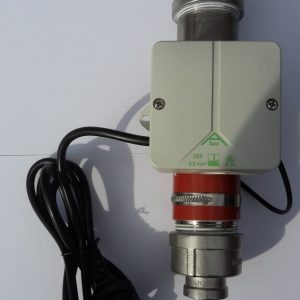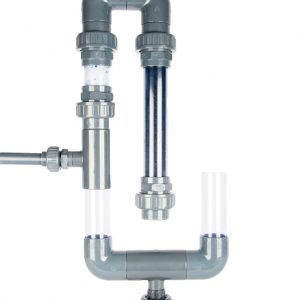Ozone destroyers
All of our ozone destroyers can be found here. We supply different kinds to break down (surplus) ozone. An ozone destroyer is sometimes also called an ozone destructor.
The simpler kind of destroyers are based on activated carbon, they are not suitable for ozone systems that operate with oxygen.
We have special destroyers for oxygen fed ozone systems. The ozone is broken down using a special catalyst. In most cases the catalyst is heated to prevent condensation. These ones are often used in the industry. They are less suitable for air fed systems.
We can also custom make a destroyer/destructor for you, for big gas streams or high ozone concentrations for example.
Please note that an activated carbon filter should never be used on an oxygen fed system, this can cause fire and explosions! Use a catalyst based destroyer instead.
Showing all 4 results
-

Ozone Destroyer HCD 100 (thermic/catalytic) Request Quote
-

Ozone Destroyer HCD 15 (thermic/catalytic) Request Quote
-

Ozone destroyer HCD50 (thermic/catalytic) Request Quote
-

Ozone Destroyer Request Quote
The controlled use of ozone gas finds applications in various industries, from water treatment to air
purification. However, managing and removing residual ozone gas after its intended use is crucial to
prevent potential harm to the environment. In this context, advanced technologies such as active
carbon, catalysts, UVC radiation and thermal destruction emerge as effective solutions for the safe
and efficient elimination of residual ozone.
Active Carbon
Active carbon, known for its exceptional adsorption capabilities, serves as a reliable method for
removing residual ozone gas. After ozone has fulfilled its purpose in disinfection or oxidation
processes, there's often a need to get rid of any excess ozone to prevent its release into the
atmosphere. Ozone rapidly reacts with active carbon, preventing ozone being released into the
atmosphere.
This technology is widely employed in ozone removal systems, particularly in applications like water
treatment plants and industrial settings where ozone is used for disinfection purposes.
Catalysts
Catalysts play a key role in transforming ozone molecules into harmless components, aiding in the
efficient removal of residual ozone. Customized catalysts can facilitate the decomposition of ozone
into oxygen. This catalytic conversion process ensures that any remaining ozone is effectively
neutralized before being released into the environment.
In air purification systems and ozone treatment facilities, catalysts provide an added layer of protection
by breaking down residual ozone, offering a sustainable solution to minimize the ecological footprint
associated with ozone gas usage.
UVC Radiation
UVC radiation offers another effective means to eliminate residual ozone gas by disrupting its
molecular bonds. Ozone molecules contain specific bonds that are susceptible to the energy delivered
by UVC radiation. This disruption leads to the breakdown of ozone into oxygen molecules, rendering it
harmless.
UVC technology is employed in ozone destruct units, where residual ozone is exposed to UVC
radiation, resulting in its complete decomposition. This method ensures the thorough removal of any
lingering ozone after its intended application, promoting both environmental safety and operational
efficiency.
Thermal Ozone Gas Destruction
The principle underlying thermal ozone gas destruction involves subjecting ozone molecules to
elevated temperatures, causing them to break down into their constituent elements. The optimal
temperature for this process typically ranges between 800 to 1,200 degrees Celsius. At these high
temperatures, the bonds holding ozone together are disrupted, resulting in the formation of oxygen
molecules (O₂) without the harmful properties associated with ozone (O₃).
